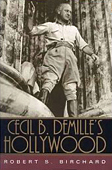
Books on the silent era of cinema.
Copyright © 1999-2025
by Carl Bennett
and the Silent Era Company.
All Rights Reserved. |
|
Cecil B. DeMille’s Hollywood
By Robert S. Birchard
|

|
BOOK REVIEW
Cecil B. DeMille’s Hollywood
By Robert S. Birchard
The University Press of Kentucky : Lexington, Kentucky : 2004
Hardcover Edition : ISBN 978-0813123240 : 430 pages
$39.95 (raised to $60.00)
Trade Paperback Edition : ISBN 978-0813180519 : 494 pages
$29.95
Reviewed by Carl Bennett
|
|
Cecil B. DeMille was a commercial filmmaker, consistently aiming his product at his audience as he understood them. Occasionally, his missed his mark. Often, his films made money — sometimes tremendous amounts of money. He was a pragmatic filmmaker who had something of an artistic streak. He was a proselytizing stumper who pushed a mass-marketable morality. He was a self-aggrandizing mover-and-shaker who controlled no power of his own. He was an on-set dictator who pummeled the craftsmen around him with criticism but who maintained a sympathetic soft spot for the actors who worked for him. He was a cinematic P.T. Barnum who didn’t fool the critics, yet his name lives on as one of the most-important filmmakers in Hollywood history.
The late Robert S. Birchard’s book is not a biography, but is a well-researched and highly-informed discussion of DeMille’s cinematic output. In his preface to the book, Birchard reveals an even-toned attitude toward his subject — not skewed by overt fanacism nor a desire for character assassination. Within the chronological assessments of the films that are the mass of the book (films which Birchard has uniquely been favored with unprecented access to DeMille’s surviving films — many prints surviving only in DeMille’s private collection) are keen observations as to the films’ relative artistic and lasting value — a guide to the discovery and/or reacquaintance of the DeMille oeuvre.
Much of the book concerns films made in the silent era because the majority of them were produced when DeMille was younger and the demand for output was higher. There are some of the DeMille films that are well-known to modern audiences due to their common availability. There are other films that remain in such obscurity that they may as well be lost — same as the seven DeMille films that are presumed lost. Birchard gives the reader insight into the films that are of questionable value, such as Manslaughter (1922), and into those that deserve modern reassessment, such as Saturday Night (1922).
Birchard also gives a tremendous amount of background information related to the production of the films culled from DeMille’s personal files, Paramount production records, and other contemporary sources. Often we are privy to the exchanges between DeMille and producer Jesse L. Lasky that shaped the films in production and determined the choices in material to come. There are letters, telegrams, and chronological markers. There is financial production information and marketplace performance data. All of which gives the reader a even-handed source from which they may come to their own DeMille conclusions.
It appears that no one knows more about Cecil B. DeMille and his films than Birchard, and we are graced with the opportunity to learn much of what Birchard has uncovered concerning DeMille over many years. This filmography (which would have been published as a photo-heavy, content-light coffeetable book in the 1980s) is a highly-valuable addition to the growing library of well-researched information on silent era films.
We highly recommend this book.
|
|
This book is available directly from . . .
|

|
|
|
|
Silent Era Home Page > Books > Cecil B. DeMille’s Hollywood
|




































